

Home Page, California Educators of the Deaf and Hard of Hearing. Hands & Voices. Useful Links « Parent Links. California Hands & Voices Dedicated to supporting families with children who are Deaf or Hard of Hearing without judgment regarding language opportunities, communication tools or educational approaches.
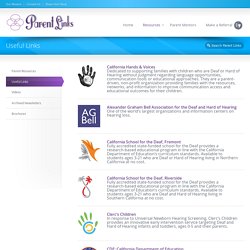
They are a parent-driven, non-profit organization providing families with the resources, networks, and information to improve communication access and educational outcomes for their children. California School for the Deaf, FremontFully accredited state-funded school for the Deaf provides a research-based educational program in line with the California Department of Education’s curriculum standards. Available to students ages 3-21 who are Deaf or Hard of Hearing living in Northern California at no cost. California School for the Deaf, Riverside Fully accredited state-funded school for the Deaf provides a research-based educational program in line with the California Department of Education’s curriculum standards. Parent Links. Get Ready to Celebrate!
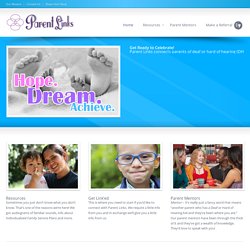
Parent Links connects parents of deaf or hard of hearing (DHH) kids to other parents of DHH kids. Resources Sometimes you just don’t know what you don’t know. That’s one of the reasons we’re here! We got audiograms of familiar sounds, info about Individualized Family Service Plans and more. Get Link’ed This is where you need to start if you’d like to connect with Parent Links. Parent Mentors Mentor – It’s really just a fancy word that means “another parent who has a Deaf or Hard of Hearing kid and they’ve been where you are.” Get Ready for Family Camp! Deaf & Disabled Telecommunications Program. Proguidlns. Assembly Bill 1836 - Deaf & Hard of Hearing. A Historic Change In September of 1994, Assembly Bill 1836, "The Deaf Children's Bill of Rights" was signed into law by then-Governor Pete Wilson.
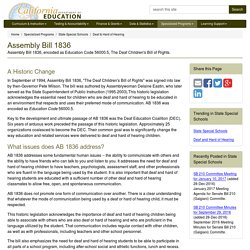
The bill was authored by Assemblywoman Delaine Eastin, who later served as the State Superintendent of Public Instruction (1995-2003).This historic legislation acknowledges the essential need for children who are deaf and hard of hearing to be educated in an environment that respects and uses their preferred mode of communication. AB 1836 was encoded as Education Code 56000.5. Key to the development and ultimate passage of AB 1836 was the Deaf Education Coalition (DEC). Six years of arduous work preceded the passage of this historic legislation.
What issues does AB 1836 address? AB 1836 addresses some fundamental human issues -- the ability to communicate with others and the ability to have friends who can talk to you and listen to you. AB 1836 does not promote one form of communication over another. Educational Interpreter Regulations - Laws, Regulations, & Policies. Dear Special Education Local Plan Area and State-operated Programs Directors (SELPA) and Special Education Administrators at County Offices (SEACO): Educational Interpreter Regulations The State Board of Education has amended two sections of Title 5 of the California Code of Regulations (CCR), Sections 3051.16 and 3065, to ensure that interpreters for pupils who are deaf or hard of hearing meet state-approved or state-recognized requirements for certification, licensing and registration or other comparable requirements.
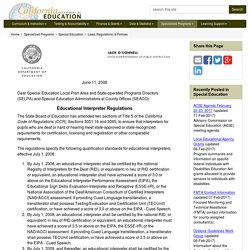
The regulations specify the following qualification standards for educational interpreters, effective July 1, 2008: Position Statement on Language Access - Deaf & Hard of Hearing. In California, there are approximately 17,000 students, ages birth to 22, who are Deaf or Hard of Hearing.
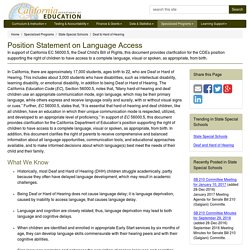
This includes about 3,000 students who have disabilities, such as intellectual disability, learning disability, or emotional disability, in addition to being Deaf or Hard of Hearing. The California Education Code (EC), Section 56000.5, notes that, “Many hard-of-hearing and deaf children use an appropriate communication mode, sign language, which may be their primary language, while others express and receive language orally and aurally, with or without visual signs or cues.” Further, EC 56000.5, states that, “It is essential that hard-of-hearing and deaf children, like all children, have an education in which their unique communication mode is respected, utilized, and developed to an appropriate level of proficiency.” What We Know The California Department of Education Believes that a strong language foundation is necessary to access education.
California School for the Deaf - Riverside. California School for the Deaf. BIlingual Bicultural Education. Childseyeshigh. Educating Children Who Are Deaf or Hard of Hearing: Total Communication. ERIC Digest. ERIC Identifier: ED414677 Publication Date: 1997-08-00 Author: Hawkins, Larry - Brawner, Judy Source: ERIC Clearinghouse on Disabilities and Gifted Education Reston VA.

Total communication (TC), a term coined by Roy Holcomb in 1967, is the title of a philosophy of communication, not a method (Scouten, 1984). Total communication may involve one or several modes of communication (manual, oral, auditory, and written), depending on the particular needs of the child. The original expectation of TC was for teachers to use the communication method(s) most appropriate for a particular child at a particular stage of development.
Therefore, there would be situations when spoken communication might be appropriate, other situations where signing might be appropriate, others that would call for written communication, and still others where simultaneous communication might work best (Solit, Taylor & Bednarczyk, 1992). TC may be used by families and educators. 1. American Sign Language. 2. 3. 4. 5. Oberkotter Foundation® Cued Speech fully enables complete, effective communication and language acquisition in families with deaf, HH or learning disabled babies, infants and children. Home. Prgsummary. ASDC Sign Language for All English Paper. Sign Language Use for Deaf, Hard of Hearing and Hearing Babies: the Evidence Supports It. Clerc Center » Our Resources » Publications » The Evidence Supports it The Clerc Center collaborated with the American Society for Deaf Children to provide Spanish and Mandarin translations to their publication, Sign Language use for Deaf, Hard of Hearing, and Hearing Babies: The Evidence Supports It.
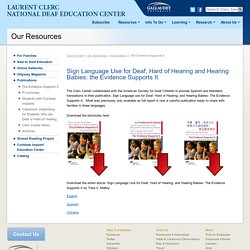
What was previously only available as full report is now a colorful publication ready to share with families in three languages. Download the brochures here: Download the entire article: Sign Language Use for Deaf, Hard of Hearing, and Hearing Babies: The Evidence Supports It by Tiara V. Malloy. English Spanish Chinese This site was supported by federal funding. Shared Reading Project. Clerc Center » Our Resources » Shared Reading Project Welcome to the Shared Reading Project!
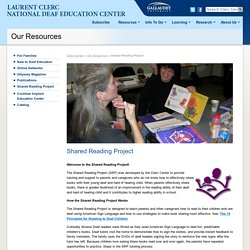
The Shared Reading Project (SRP) was developed by the Clerc Center to provide tutoring and support to parents and caregivers who do not know how to effectively share books with their young deaf and hard of hearing child. When parents effectively share books, there is greater likelihood of an improvement in the reading ability of their deaf and hard of hearing child and it contributes to higher reading ability in school. How the Shared Reading Project Works The Shared Reading Project is designed to teach parents and other caregivers how to read to their children who are deaf using American Sign Language and how to use strategies to make book sharing most effective. Culturally diverse Deaf readers were filmed as they used American Sign Language to read fun, predictable children's books. Once a week, a deaf tutor visits each home. Parent and Caregiver Comments Additional Resources.
The 15 Principles for Reading to Deaf Children - Reading to Deaf Children; Learning from Deaf Adults. Clerc Center » Info to Go » Literacy » Literacy-It All Connects » Reading to Students Read to students every day and at all grade levels.

Reading to students daily improves students' visual skills, builds vocabulary, and increases reading comprehension. The Role of the Educator is: to establish a literacy-rich environment,to share good books,to demonstrate appropriate reading behavior,to engage students by reading fiction books, non-fiction books, magazines, comics, and newspapers, andto read materials related to themes. Observers Will See: the educator engaging students in learning how to read,students making predictions and discussing what is read,students demonstrating comprehension, andthe educator noticing and commenting on what students are doing well.
Sign Language Resources for Interpreters, Parents, and Students.